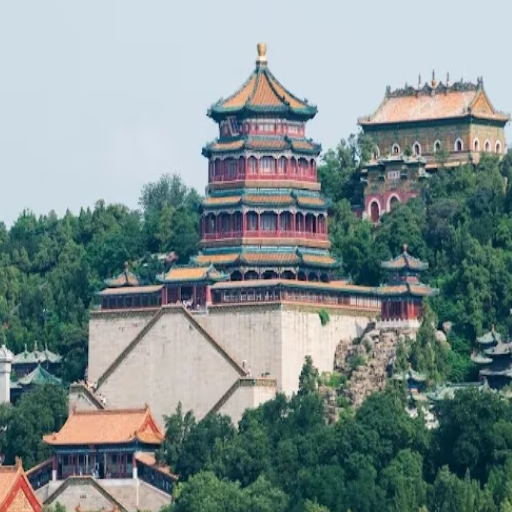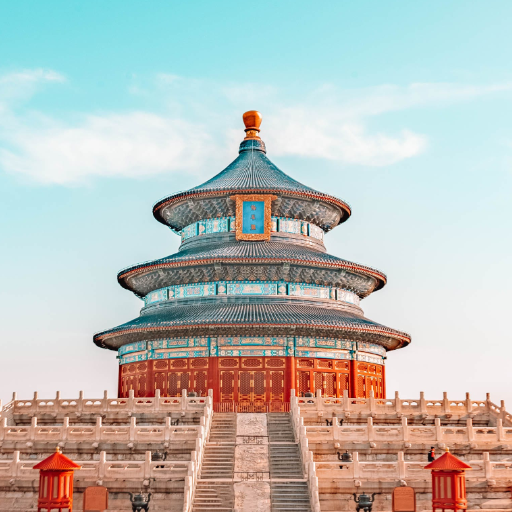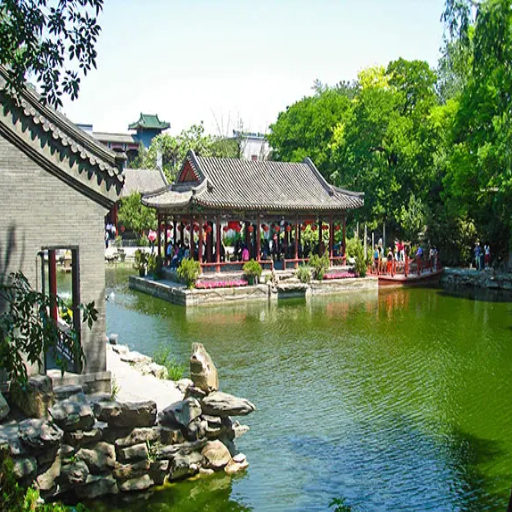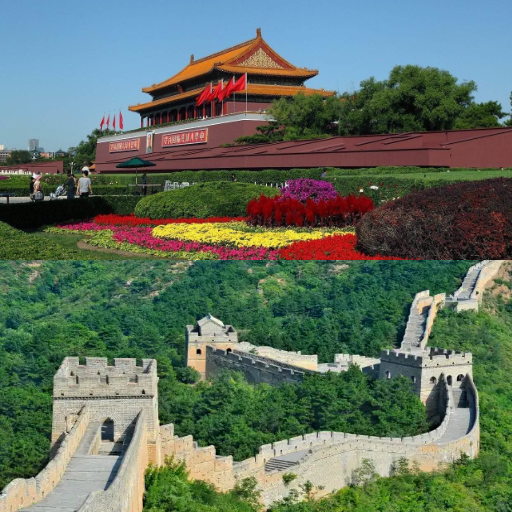As rich in history as it is in culture, China’s capital city, Beijing, has admired the fast-paced changes in the modern world while holding on tightly to its ancient traditions. Due to the commingling of cultures, the city has countless eye-catching landmarks that tell the story of its imperial past and the modern future. Guided imperial palaces, bubbling markets, and new-age skyscrapers are eye candy that no one can miss. This guide will take you through the must-see attractions and top things to do, helping you uncover the city’s marvelous charm, delicious food, and enticing vibes. Those passionate about history, food, or adventure will always find something unique in Beijing.
What Are the Top Beijing Attractions You Must Visit?

Exploring the Forbidden City: A Step Back in Time
The Forbidden City, also known as the Palace Museum, is a massive piece of architecture that was once the royal palace of the Ming and Qing dynasties. This site in Beijing is part of UNSESCO’s world heritage sites and is often frequented by travelers looking to learn more about China’s rich history. While its yardage is around 180 acres, it has 980 buildings, more than 8,700 rooms, and traditional Chinese architecture and motifs, making it stand out from the others.
The Meridian Gate, the Hall of Supreme Harmony, and the Imperial Garden are essential. Plan on spending at least half a day in the complex, and make sure to arrive as early as possible to avoid long waiting lines. Order comfortable shoes and have a plan for what you want to get out of your visit. To get the best experience, refer to the official website for the Palace Museum regulations and visitor requirements, as well as the latest entry times and ticket prices.
Why the Great Wall Is a Must-See
The Great Wall of China is one of the most historic and beautiful landmarks of equal importance to engineering marvels. Standing 13,000 miles long, this ancient structure showcases the incredible skill of the Chinese people but also represents the strength and resilience of the country as a whole. Construction of the wall began in the 3rd century BCE and was put into place as a protective shield for invasions and break-ins against the Chinese states and empires. This beautiful landmark has become a UNESCO World Heritage Site and boasts culture and history.
The Great Wall is built using materials like bricks, stones, and tamped earth found in different regions. Certain parts of the Great Wall, such as Andrews and Mutianyu, are classic examples of the fantastic skills employed in construction. Apart from that, other parts of the wall feature stunning craftsmanship by showcasing numerous watch towers, parapets, and other custom-built steep climbs along the outline of the region. Being physically fit during steep climbs towards parts like Jiankou and Simatai is vital, so wear sturdy footwear and have enough water beforehand. Visitors of the wall will be amazed at its beauty and the rich culture it offers, which adds to the sheer scale of the landmark.
Undoubtedly, the Great Wall has stunning beauty and nature to offer. Visitors can experience different landscapes due to the grand wall traversing through deserts, mountain ridges, and plains. For example, Jinshanling and Huanghuacheng’s locations are specific to their picturesque landmarks, especially during autumn when the greenery turns golden. In addition, less populous sections are more tranquil, which makes the visit more peaceful and gives more privacy for nature lovers. The massive wall is an extraordinary destination no matter your reasons for visiting, be it its historical importance, architectural wonders, or scenery.
Unveiling the Treasures of Summer Palace
An exceptional Chinese landscape design, The Summer Palace is an imperial garden in Beijing that combines the best of natural beauty and architectural excellence. It covers an estimated area of 2.9 square kilometers and has Kunming Lake and Longevity Hill, which, as a whole, cover about 3/4 of the area. The palace even has a simulated natural balance and incorporates traditional Chinese philosophies, like the Yin and Yang.
Construction Era: It was built in 1750 during the Qing Dynasty and was reconstructed after suffering damage in 1860.
Architectural Highlights: China’s Long Corridor, Marble Boat, and the Seventeen Arch Bridge were all constructed with detailed architecture and intricate cultural symbolism.
Cultural Significance: The palace shows signs of ancient art, imperial culture, and water engineering techniques of that era.
It’s highly recommended to dive into a part of history that promises experiences of peace, serenity, and dramatic, eye-catching views. The Summer Palace is bound to capture the attention and interest of those wanting to marvel at art or engineering masterpieces.
How to Best Experience Things to Do in Beijing?

Discovering Hutongs and Their Unique Charm
Hutongs are small alleys that cut across historic areas of Beijing and reveal the city’s deep history and culture. By taking a trip around the hutongs, tourists can see traditional courtyard houses, local art, and people’s daily lives. Some famous hutongs are Nanluoguxiang and Wudaoying Hutong. All of them have their style and rich local culture.
Cultural Immersion: Meet people from local communities, eat traditional dishes from small eateries, or visit local museums.
Architectural Highlights: Look out for the exquisite Siheyuan (courtyard houses); their striking balanced symmetry.
Photography Opportunities: Take beautiful photos of old gates, vibrant markets, and stunning red lanterns.
For genuine Beijing experiences, absorbing the essence at a leisurely pace is crucial – and the easiest way to do this is by walking or renting a bicycle around the hutongs.
A Stroll Through Tiananmen Square and Its Significance
In the historical and cultural heart of Beijing stands Tiennamen Square, which is of prominent importance. As one of the largest public squares, it set its own records with an area of approximately 440,000 meters. Many distinct structures, like the Great Hall of the People, the National Museum of China, and the Mausoleum of Mao Zedong, add to the beauty of this eye-catching site.
Deeply connected to the history of China, Tiananmen Square has been the focal point of many movements that tell us how the current modern face of China came into being. The square also features a tribute for the heroes of the people, which serves as a mark for every citizen. Many visit to experience the flag ceremony at sunrise, and feelings of nationalism swell in every patriot’s heart when they witness the phenomenon.
The square’s symmetrical outline and general planning add to its beauty while making it open and free. The area serves as a gathering point for political events and heads of state; thus, the urban design surrounding the square is perfectly aligned. Offering a rich blend of architectural wonders, history, and culture, visiting Tiananmen Square should be on every tourist’s bucket list.
Visiting the Temple of Heaven for a Spiritual Retreat
Famous as an attraction in Beijing, the Temple of Heaven is regarded as one of the most remarkable pieces of Chinese architecture. It symbolizes spirituality. The enormous temple complex served the emperors of the Ming and Qing Dynasties for ritual purposes, where they prayed for good harvests annually. The architecture’s Taoist cosmology and engineering are exceptional.
Yuanqiu Tan or the Circular Mound Altar: The tiered structure symbolizes a connection to Heaven and showcases infinite space. Its ultra-precise geometry enhances spiritual resonance.
Qinian Dian, or the Hall of Prayer for Good Harvests, is another example of magnificently advanced wood architecture and structural ingenuity. It was built without nails.
Simply, three echo stones, along with stone walls, demonstrate the ancient wisdom of acoustics and the ability to capture and amplify sound across vast distances.
Temple of Heaven has it’s spiritual importance and allows one to admire the structure’s intricate architectural and philosophical features.
Where to Stay in Beijing for Easy Access to Key Sites?

Choosing the Right Hotel in the Heart of Beijing City
While planning a trip to Beijing, the hotel of your choice should be strategically located near the Forbidden City, Tiananmen Square, and the Temple of Heaven. These three impressive sites serve as landmarks of Beijing and should be considered when picking a suitable hotel.
Location
Make sure the hotel you select is next to the metro lines. This will provide seamless connectivity to anywhere you want to go.
Being closer to cultural sites means less time traveling and more time sightseeing.
Amenities
Staying in hotels that provide room amenities such as complimentary Wi-Fi, air conditioners, and modern bathrooms can increase comfort.
On-site dining, fitness centers, and concierge services can enhance your stay.
Budget
Most central districts are served by mid-range hotels that are pricable and highly recommendable.
Be on the lookout for rate peaks during certain parts of the season, as they fluctuate the most.
Reviews and Ratings
You should check reviews on Trip Advisor or Booking.com and look for other travelers’ experiences, as that helps you plan beforehand.
For peace of mind, look for properties with better than 8.0/10 ratings—you will get reliability and satisfaction.
Considering all these factors will help you strategically view the enticing landmarks of Beijing.
Benefits of Staying Near Wangfujing
For visitors looking for cultural immersion while in Beijing, staying close to Wangfujing has many perks. Below are the advantages of booking accommodation in this vicinity:
Strategic Location to Important Sights:
Conveniently, iconic places like The Forbidden City and Tiananmen Square are either a walking distance away or a short ride away.
With easy access, the travel time is significantly reduced, which enhances the sightseeing experience.
Extraordinary Shopping and Cuisine:
Known for its high-end shops located within the Wangfujing area, street vendors, local boutiques, and Wangfujing surprise many.
Dining options also range from traditional Beijing snacks to more upmarket establishments.
Excellent Public Transportation:
The area is accessible through bus routes and subway lines (Line 1), making traveling around the city very convenient.
Easy access to taxi services and bike sharing further improve the experience.
Religious and Cultural Sites:
Nearby museums, art galleries, exhibitions, or historical landmarks enable the locals to practice cultural traditions.
The lively and colorful night markets are an opportunity to learn more about the lifestyle of the locals.
Great Accommodation Features:
The area has everything from budget accommodations to high-end ones, most of which have great reviews (8.0 and above on TripAdvisor).
Due to the influx of tourists in the Wangfujing area, comfort and modern amenities are often guaranteed.
Travelers can boost their experience in Beijing by taking advantage of enhanced convenience and exposure to services and culture provided by this region.
Exploring Courtyards for a Traditional Experience
Spending time in a traditional Chinese courtyard, or siheyuan, gives tourists a chance to understand the history and culture of Beijing. These forms of accommodation are usually preserved or renovated traditional buildings with Chinese architectural styles, which tend to be traditional symmetric designs with a central courtyard. These traditional buildings serve as quiet, peaceful hiding places away from busy streets.
Location: Most Chinese courtyards are located in the Hutongs around the Forbidden City. This location is advantageous for tourists since they can easily visit the city’s cultural attractions.
Room Amenities: Always check if the courtyard has the most basic amenities, like central heating, Wi-Fi, and Air conditioning, because this matters a lot for people traveling in extreme heat or cold.
Size and Capacity: Proper intel on the maximum headcount will save you booking time, as intimacy and exclusivity tend to be hallmarks of many courtyards.
Preservation Standards: The opposite extreme of modern hospitality is building hotels without soul or character. Renovated for comfort’s sake but still having traditional charm courtyards is the best pick.
Ratings and Reviews: The only positive assurance you need is that guests of the courtyards gave them high ratings (8.0+ recommended), which serve as an essential benchmark for quality and service assurance.
By carefully selecting the right courtyards, you ensure your stay in Beijing will be as authentic as possible while providing comfort and convenience alongside cultural immersion.
What Are the Best Things to Eat While in Beijing?

Savoring the Famous Peking Duck
I recommend being vigilant while selecting a restaurant serving Peking duck in Beijing, as some fantastic options serve the dish exquisitely. At the same time, some do not do it justice. As for me, I prefer to visit restaurants that use authentic roasting techniques for their ducks and cook them in fruitwood-fired ovens to get that perfect crispy skin over tender meat. A few key technical parameters are:
Skin Crispy Level—This is probably the most essential factor. The skin should not only be crispy but also light, almost to the point of being fragile. Making the skin this crispy involves meticulous planning and execution, as the duck is air-dried before properly cooked.
Nominations – The use of duck hoisin or sweet bean sauce must match the amount of duck served and not take over, and barbeque sauce pancakes have to be soft enough to wrap quickly.
Serving Style: I prefer places where the duck is finely cut to pieces right in front of the customer, showcasing the chef’s mastery.
Reputation/Reviews—I find comfort in the fact that a restaurant with very good dining reviews (generally 4.5 stars or 9.0+ on review sites) serves the dishes authentically and correctly.
With these parameters, tourists can experience this Beijing specialty and have a delightful meal. Aim for a restaurant that ticks all these boxes, and you will not be disappointed.
Exploring Street Food in Beijing
While sampling street food in Beijing, I look for a few things to ensure I get an authentic and memorable experience. To begin with, hygiene is essential—street vendors must show evidence of clean practices, like proper sanitization of the cooking area, use of fresh ingredients, etc. If hygiene is neglected, it will indeed reflect on food safety, and my culinary adventure won’t be enjoyable.
Next, authenticity is also essential to me. I make an effort to find vendors regarded for their traditional-era recipes, as they only offer insight into the rich culture of Beijing. For example, traditional food that should be prepared from a Beijing perspective, such as Jianbing or lamb skewers, must be made using older techniques. That way, the quality and taste of food would meet local expectations and fully represent the city.
Finally, I prefer well-known food stalls. A constant flow of customers is a significant parameter that indicates the food is fresh and of good quality. Such places usually have food with fast turnover, suitable for safety and great taste. For all these reasons, my street food experiences in Beijing are safe and satisfying and allow me to enjoy the city entirely.
Dining in Authentic Chinese Restaurants
While eating at a Chinese restaurant, my number one consideration is the surrounding environment and how the menu correlates to a specific region. I pay attention to the style of the restaurant and whether it is decorated in a particular regional style, like Sichuan, Cantonese, or Shanghainese cuisine. That is important because it guarantees the food follows authentic techniques and flavors.
Quality of ingredients: Freshly obtainable local products are a priority. These types of restaurants usually have better quality taste and authenticity.
Methods of cooking: Stir-frying, steaming, and braising are signs of lower-quality dishes that lack culinary skills.
Menu: An authentic Chinese restaurant should boast well-balanced dishes that are holistic in nature, featuring various textures, flavors, and spices, including sweet, sour, and spicy, which represent the philosophy of Chinese dining.
Place of Service: Real establishments usually serve dishes to be shared family-style and in a specific order for easier customs to follow.
Keeping the sentences relatively the same length and straightforward allows me to capture the true meaning and essence of Chinese culture, in this case, when dining out at a restaurant.
When Is the Best Time to Visit Beijing?

Understanding Beijing’s Climate and Seasons
Spring and autumn, or April to May and September to October, respectively, are my preferred times to visit Beijing because of the mild weather. The average temperatures during those times range between 10-21 degrees Celsius or 50-70 degrees Fahrenheit. This mild weather provides opportunities for outdoor activities like visiting the city’s historical sites. Flowers bloom, the skies are clear in spring, whereas autumn shows off crisp air mingled with beautiful fall leaves.
From a technical standpoint, spring and autumn are very advantageous for photographers due to the low levels of pollution in the air and optimal soft lighting, unlike summer and winter. Enjoyable humidity levels also assist in comfort while sightseeing since these months do not experience the bitter cold of winter or the sweltering heat of summer.
Events and Festivals to Plan Your Visit Around
Autumn is a great time to visit the area to witness what the region offers; local celebrations such as harvest festivals, autumn markets, and cultural shows are must-attend. These festivals showcase produce, traditional crafts, and performances, uniting the spirit of the community. These festivals also coincide with the peak foliage in October, which is accompanied by relatively good weather. Most of these festivities take place around October and early November. Traditional dances and crafts accompanied by theater afresh in the warm climate make the region wonderfully colorful.
More practically, the more precise and moderate lighting during the Season brings along excellent opportunities for photography to capture the beautifully energized fuel of the festivities. The blend of moderate temperature alongside 50-60% humidity is why these months are accompanied by super comfortable weather, which makes exploring outdoor venues more enjoyable. Blending super relaxed travel with beautifully crafted streams of activity offers tourists a wholesome experience that is wonderfully vibrant.
Strategies for Travelling Around Busier Holiday Periods
If you’re traveling during peak seasons, you may want to set a plan beforehand to experience the most and handle the crowds more effectively. To start, set a reasonable time to purchase accommodation and ticketing because the pricing usually fluctuates with time. I recommend visiting these vacation spots in the early morning or late evening since crowd sizes will be more manageable.
From a technical standpoint, for photography lovers, these times may offer varying lighting depending on the time of day, with the best exposures being captured in the morning and evening. In addition, when vacationing in hotter areas that attract many feet, I try to adjust my photography style by taking advantage of faster shutter speeds and isolating elements within an image that tell powerful stories. The amount of moisture in the air during peak holiday seasons, usually from 50 to 60 percent, can affect the casing of the camera, which is why I always take lens-clearing tools along.
Coupled with the fickle temperatures, I ensure that I pack lightly so that I can prepare appropriately for the varying weather. If actioned thoughtfully, even in major tourist areas, these steps help ensure a more convenient experience.
Frequently Asked Questions (FAQs)
Q: What attractions are a must for those looking to explore Beijing for the first time?
A: First-time travelers in Beijing should not miss the Great Wall of China Mutianyu Section, the Forbidden City, and the Summer Palace. These attractions provide insight into Chinese history and culture. I highly recommend exploring these sights to learn more about the region.
Q: How can I best enjoy Beijing’s Great Wall of China?
A: The Mutianyu and Badaliing portions are known to provide breathtaking views, making them ideal for visitors. However, I suggest visiting Mutianyu as it is less frequented. Having a tour guide accompany you can also be beneficial, as they can share relevant information about the wall’s history.
Q: What is the significance of the Lama temple in Beijing?
A: Lama Temple, or Yonghe Temple, is one of the Tibetan Buddhist temples in Beijing. It is appreciated for its wonderful design and meticulous paintings, which are part of Chinese art. This temple, along with several others, plays a critical part in Beijing’s religion.
Q: Are there hidden gems in Beijing that are not well known but still worth exploring?
A: In addition to the numerous popular sites, the hutongs (traditional alley and courtyard homes) are fascinatingly unique. Jingshan Park, located right beside the Forbidden City, is well known for its astonishing views of the city and is certainly a place you do not want to miss!
Q: What are some tips for navigating the Beijing subway system?
A: If someone is visiting Beijing, they must know that the Beijing subway is the best way to get around the city. To navigate the subway, it is best to buy a rechargeable subway card, keep a map nearby, and avoid traveling during the busy peak hours. Most signs and announcements are also made in English, so International travelers will also be able to understand them easily.
Q: Can you recommend any art galleries or museums in Beijing?
A: The best two places would be the National Museum of China and the 798 Art District. The National Museum holds many collections of Chinese art and history; furthermore, the 798 Art District is famous for its contemporary art and modern galleries and exhibitions.
Q: What is the best way to experience local cuisine in Beijing?
A: It is well known that no trip to Beijing would be complete without eating the famous Beijing roast duck. Try dining at traditional restaurants like Quanjude or Da Dong. Strolling through local markets and eating at street food tents also gives an impression of the metropolitan’s food culture.
Q: Do you have any tips for day trips from Beijing?
A: I recommend a day trip to the Summer Palace, a UNESCO World Heritage site. Its beautiful gardens and historical significance would further enhance the trip to Beijing. In addition, a day trip to the Ming Tombs or the countryside surrounding Beijing would help you appreciate the region’s history and culture.
Q: What recommendations do you have for visiting the Forbidden City?
A: You will want to think about purchasing tickets to the Forbidden City in advance so you won’t be stuck in long lines. You will also want to make sure you allow a few hours to appreciate the largest palace complex in the world. This is in addition to hiring a tour to help you understand the history and significance of this site in Beijing.